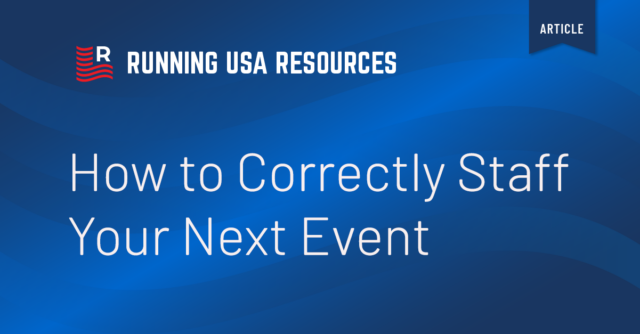By Kelly O’Mara
You’re ready to get your event off the ground or take it to the next level, but besides doing absolutely everything yourself and roping in friends to help you, you’re not sure how to staff the race: How many people do you need? Should they be volunteers or employees? Where do you even find them?
“It’s taken lots of years to kind of figure it out,” said Heidi Swartz, executive director for the Cowtown Marathon and its associated non-profit, C.A.L.F., which puts on smaller local races, training programs, and kids’ events throughout the year.
One of the things she’s figured out over the years is what questions and considerations a race director needs to be asking themselves about staffing events.
That should include some things not all race directors are paying attention to, said Kelly Burns Gallagher, a labor and employment attorney, who also runs a coaching business and organizes two charity running races—namely she means employment law and your liability.
“There’s no great answer, but there are ways to mitigate risk,” she said.
What to know about employment law when it comes to events
When it comes to the law, there’s a big difference between for-profit and non-for-profit events. Non-profit organizations have a lot more wiggle room for using volunteer labor, because those people are volunteering for the non-profit’s mission. For-profit races, on the other hand, start to get into some risky areas when it comes to labor law and liability, no matter how great the race is, said Burns Gallagher. She uses this example: No matter how much someone loves Walmart and believes in it, if they put on a blue vest and start greeting people at the door, Walmart legally has to pay them.
This is partially why some of the biggest race organizers, like New York Road Runners, operate as non-profits, with the mission of promoting health and wellness/
If you’re just getting a race up-and-running, said Burns Gallagher, a good place to start is to partner with a non-profit organization (which can even be a running club, as long as it’s set-up correctly) and operate under that umbrella. This works easily for many small charity events, and is how she runs the two local running races she puts on to raise money for partner nonprofit organizations. For those hoping to make a business of their events company, partnering with a non-profit can still be a good option and can pay out a salary to the RD or can be set-up as a licensing arrangement with the non-profit, if you structure it correctly. (Please check with your own lawyer.)
“There’s no way you can completely insulate yourself from liability,” said Burns Gallagher, but there are some things to keep in mind.
Volunteers
Yes, most races use volunteers in some capacity—handing out water, checking in athletes, awarding medals. Burns Gallagher knows that, you know that, we all know that. But just because it’s a common practice doesn’t mean it’s necessarily legal.
There are a few things that are legal red flags when it comes to volunteers, she said:
– You can’t pay people to do something and then also have volunteers doing the same thing.
– You can’t have volunteers doing things that are “essential to the function of the business.”
These are both issues that have come up in various legal cases regarding whether a company had liability for people volunteering at an event. The one major case that was filed about volunteers specifically at a running race was dismissed on a technicality (and so the underlying legal arguments weren’t decided), but Burns Gallagher said it’s still only a matter of time before this comes again to a head in court.
In addition, however, to the possible liability and employment issues, you probably don’t want volunteers in key jobs simply for your own peace of mind—it’s always better to have someone getting paid in positions that really matter. “The higher the risk, the more you want to put a staff person on it,” said Matt West, CEO of DSME Sports, which operates as a large event management company that is then hired by race organizers to direct and manage events.
Contractors
Almost every race also relies on contractors—ie. people who are brought in for specific jobs—whether just around the race weekend or in the weeks leading up. Whether or not someone should be a contractor or a part-time employee is a question both, again, of your individual needs and also the employment law where you operate.
The key litmus test—though it varies in some states where laws are stricter, such as California and New York, and where agencies are cracking down on the mislabeling of employees in the wake of concerns around ride-sharing and delivery apps—is: Does the contractor operate independently? Do they have their own equipment and methods of completing the task? Do you give them direct instruction?
Think of a timing company, for example, said Burns Gallagher. You hire the best timing company you can find and tell them what you need. They set up their equipment, know what they’re doing, and time the race. You don’t tell them how to do their job. They’re an independent contractor.
This can extend to plenty of jobs within a race: security, website design, potentially things like a volunteer manager or an expo coordinator.
If they don’t meet the definition of a contractor, then what you have is a part-time employee.
Part-time & full-time staff
Most races, as they get off the ground, simply don’t have the funding for year-round full-time staff. And that’s totally fine. It’s as you grow that issues start to arise around your own capacity, what you can do best (and what it makes sense to hire someone who is better at the task), and what roles to add to help the business expand.
DSME, for instance, has five full-time staff and three part-time and then they contract with dozens of specialists in their fields for specific tasks, depending on the event they’re running and the needs of that race. Swartz has six full-time staff and a working board of directors for the non-profit organization, and she relies heavily on lead volunteers who are helping with the mission of the org.
Where to start
Before figuring out how many staff you need, though, the best place to start is with creating an event plan, said West, and working backwards—because what kind of staff and how many will depend on the specifics and complexity of what you want to do. For the many events DSME operate, he designates an event lead within his staff, creates an event plan, and then has captains for each area (start line, course, finish, post-race festival, expo). Some of those might be part-time staff and some might be contractors, who are specialists in their field and are self-directed—ie. a person who’s really good at organizing expos. It’s up to the captains to manage their areas and determine how many people they need.
As you grow, ask yourself: What are your core needs or your most important jobs? What are you best at it and should focus on, and what should you bring in someone else for?
Swartz was doing almost everything herself at first, when there was just one race and 12,000 runners. As they expanded, the first thing person she hired was someone to manage the course, so she could know that was taken care of while she was at the start/finish. The next job she hired was someone in charge of registration. If she was starting out today, she said, she’d hire a marketing and social media staff person early on.
All of those positions were easy to justify to her board—who she also relies on to work on race weekend—because hiring those roles would lead to increases in registration and help fund themselves.
That’s the next question you have to work through in your budget: What can you sustainably afford? How are you going to pay for these positions? And who can fill the roles?
Where to find staff
This might be the $10,000 question right now, particularly in the COVID event era: finding the best event staff. It may also determine the answers to some of the challenges we’ve just presented.
Networking at an organization/annual conference like Running USA is great, said West, as is working other events yourself as you come up through the industry to meet people, hiring may also depend on who you have access to.
Swartz often uses interns, through an arrangement with the local college that teaches them about the industry, and then may hire a few on. She also taps into the volunteer network that’s been involved with the non-profit, because those people are often the most passionate about the mission.
“You want to make sure they understand it’s not an 8-to-5 job,” she said.
Summary of key takeaways
· Staffing presents unique complications for events of all sizes
· Create a rock solid event plan to help determine your staffing needs
· It’s always best consult with an employment attorney to make sure liability issues are accounted for
· Volunteers are an asset, but avoid placing them in high-risk roles or jobs that duplicate staff responsibilities
· When it comes to contractors, be aware of all state laws and regulations
· Networking and industry contacts can be key to finding great staff members
About the Author

Kelly O’Mara is the former editor-in-chief of Triathlete Magazine and the founder of the Triathlonish newsletter.

